Spatio-Temporal Variations in Grassland Carrying Capacity Derived from Remote Sensing NPP in Mongolia
Abstract
1. Introduction
2. Materials and Methods
2.1. Study Area
2.2. Data Sources
2.2.1. Climate Data
2.2.2. GLASS and MODIS Products
2.2.3. Field Data
2.2.4. Vegetation Zone
2.3. Methodology
2.3.1. Estimation of Regional AGB
2.3.2. Estimation of GCC
2.3.3. Correlation Analysis of the AGB and Climate Variables
2.3.4. Mann–Kendall Trend Test
3. Results
3.1. Validation of Aboveground Biomass
3.2. Comparison of the Spatiotemporal Variations in AGB from GLASS and MODIS Products
3.3. The Influence of Climate on Grassland Productivity
3.4. Multi-Year Trends of Livestock Number
3.5. Spatiotemporal Variations in GCC
4. Discussion
4.1. Comparison of GLASS and MODIS Products and Their Biomass
4.2. Influence of Climate Factors on Grassland Above-Ground Biomass
4.3. Spatio-Temporal Pattern of GCC and Its Effects from Livestock
4.4. Regional GCC and Grazing Management
5. Conclusions
Author Contributions
Funding
Data Availability Statement
Conflicts of Interest
References
- Suttie, J.M.; Reynolds, S.G.; Batello, C. Grasslands of the World; Food and Agriculture Organization: Rome, Italy, 2005. [Google Scholar]
- Latham, J.; Cumani, R.; Rosati, I.; Bloise, M. FAO Global Land Cover SHARE. Database Beta-Release Verion 1.0. 2014; p. 40. Available online: https://www.fao.org/uploads/media/glc-share-doc.pdf (accessed on 4 June 2025).
- ILRI; IUCN; FAO; WWF; UNEP; ILC. Rangelands Atlas. 2021. Available online: https://www.ilri.org/knowledge/publications/rangelands-atlas (accessed on 15 May 2023).
- Lemaire, S.A.; Russell, L. Epidemiology of thoracic aortic dissection. Nat. Rev. Cardiol. 2011, 8, 103–113. [Google Scholar] [CrossRef]
- Bengtsson, J.; Bullock, J.M.; Egoh, B.; Everson, C.; Everson, T.; O’Connor, T.; O’Farrell, P.J.; Smith, H.G.; Lindborg, R. Grasslands—More important for ecosystem services than you might think. Ecosphere 2019, 10, e02582B. [Google Scholar] [CrossRef]
- Sala, S.; Crenna, E.; Secchi, M.; Pant, R. EUR 28984 EN; Global Normalisation Factors for the Environmental Footprint and Life Cycle Assessment; Publications Office of the European Union: Luxembourg, 2017; pp. 1–16. [Google Scholar]
- Sunjidmaa, N.; Mendoza-Lera, C.; Hille, S.; Schmidt, C.; Borchardt, D.; Graeber, D. Carbon limitation may override fine-sediment induced alterations of hyporheic nitrogen and phosphorus dynamics. Sci. Total Environ. 2022, 837, 155689. [Google Scholar] [CrossRef] [PubMed]
- Asner, G.P.; Elmore, A.J.; Olander, L.P.; Martin, R.E.; Harris, T. Grazing systems, ecosystem responses, and global change. Annu. Rev. Environ. Resour. 2004, 29, 261–299. [Google Scholar] [CrossRef]
- Qinxue, W.; Tomohiro, O.; Tadanobu, N.; Batkhishig, O.; Bayarsaikhan, U. Estimation of the Carrying Capacity and Relative Stocking Density of Mongolian grasslands under various adaptation scenarios. Sci. Total Environ. 2024, 913, 169772. [Google Scholar] [CrossRef]
- Han, Z.; Song, W.; Deng, X.; Xu, X. Grassland ecosystem responses to climate change and human activities within the Three-River Headwaters region of China. Sci. Rep. 2018, 8, 1–13. [Google Scholar] [CrossRef]
- Xu, M.-Y.; He, J.-S. A review of grassland carrying capacity: Definition, theoretical consideration and model. Acta Prataculturae Sin. 2014, 23, 313. [Google Scholar]
- Nana, Y.; Weiwei, Z.; Wu, B.; Tuvdendorj, B.; Chang, S.; Mishigdorj, O.; Zhang, X. Assessment of the grassland carrying capacity for winter-spring period in Mongolia. Ecol. Indic. 2023, 146, 109868. [Google Scholar] [CrossRef]
- Leeuw, J.d.; Rizayeva, A.; Namazov, E.; Bayramov, E.; Marshall, M.T.; Etzold, J.; Neudert, R. Application of the MODIS MOD 17 Net Primary Production product in grassland carrying capacity assessment. Int. J. Appl. Earth Obs. Geoinf. 2019, 78, 66–76. [Google Scholar] [CrossRef]
- Holechek, J.L. An Approach for Setting the Stocking Rate. Rangelands 1988, 10, 10–14. [Google Scholar]
- Hunt, E.R.; Miyake, B.A. Comparison of stocking rates from remote sensing and geospatial data. Rangel. Ecol. Manag. 2006, 59, 11–18. [Google Scholar] [CrossRef]
- Yu, L.; Zhou, L.; Liu, W.; Zhou, H.K. Using Remote Sensing and GIS Technologies to Estimate Grass Yield and Livestock Carrying Capacity of Alpine Grasslands in Golog Prefecture, China. Pedosphere 2010, 20, 342–351. [Google Scholar] [CrossRef]
- Jong, S.M.d.; Meer, F.D.v.; Clevers, J.G. Basics of Remote Sensing; Springer: Berlin/Heidelberg, Germany, 2004; pp. 1–15. [Google Scholar] [CrossRef]
- Coops, N.C.; Tooke, T.R. Learning Landscape Ecology; Springer: Berlin/Heidelberg, Germany, 2017. [Google Scholar] [CrossRef]
- Langley, S.K.; Cheshire, H.M.; Humes, K.S. A comparison of single date and multitemporal satellite image classifications in a semi-arid grassland. J. Arid Environ. 2001, 49, 401–411. [Google Scholar] [CrossRef]
- He, C.; Zhang, Q.; Li, Y.; Li, X.; Shi, P. Zoning grassland protection area using remote sensing and cellular automata modeling—A case study in Xilingol steppe grassland in northern China. J. Arid Environ. 2005, 63, 814–826. [Google Scholar] [CrossRef]
- Li, Q.; Wang, J.; Xie, H.; Ochir, A.; Davaasuren, D. Applicability of Grassland Production Estimation Using Remote Sensing for the Mongolian Plateau by Comparing Typical Regions in China and Mongolia. Sustainability 2022, 14, 3122. [Google Scholar] [CrossRef]
- Zhao, Y.; Chi, W.; Kuang, W.; Bao, Y.; Ding, G. Ecological and environmental consequences of ecological projects in the Beijing–Tianjin sand source region. Ecol. Indic. 2020, 112, 106111. [Google Scholar] [CrossRef]
- Chen, J.; Li, F.; Wang, R.; Fan, Y.; Raza, M.A.; Liu, Q.; Wang, Z.; Cheng, Y.; Wu, X.; Yang, F.; et al. Estimation of nitrogen and carbon content from soybean leaf reflectance spectra using wavelet analysis under shade stress. Comput. Electron. Agric. 2019, 156, 482–489. [Google Scholar] [CrossRef]
- Liu, Y.; Zhang, Z.; Tong, L.; Khalifa, M.; Wang, Q.; Gang, C.; Wang, Z.; Li, J.; Sun, Z. Assessing the effects of climate variation and human activities on grassland degradation and restoration across the globe. Ecol. Indic. 2019, 106, 105504. [Google Scholar] [CrossRef]
- Yang, Z.; Wei, Y.; Fu, G.; Xiao, R.; Chen, J.; Zhang, Y.; Wang, D.; Li, J. Decreased precipitation in the late growing season weakens an ecosystem carbon sink in a semi-arid grassland. J. Appl. Ecol. 2021, 58, 2101–2112. [Google Scholar] [CrossRef]
- Mongolian Academy of Sciences. National Atlas of Mongolia; Mongolian Academy of Sciences: Ulaanbaatar, Mongolia, 2022. [Google Scholar]
- Consolidated Report on Mongolia’s Unified Land Fund 2018; Agency of Land Administration and Management, Geodesy and Cartography: Ulaanbaatar, Mongolia, 2019.
- Shagdar, E. The Mongolian livestock sector: Vital for the economy and people, but vulner-able to natural phenomena. Erina Rep. 2002, 47, 4–26. [Google Scholar]
- Keeling, C.D.; Chin, J.F.S.; Whorf, T.P. Increased activity of northern vegetation inferred from atmospheric CO2 measurements. Nature 1996, 382, 146–148. [Google Scholar] [CrossRef]
- Tans, P.P.; Bakwin, P.S.; Guenther, D.W. A feasible Global Carbon Cycle Observing System: A plan to decipher today’s carbon cycle based on observations. Glob. Change Biol. 1996, 2, 309–318. [Google Scholar] [CrossRef]
- Methodology of Estimate for Grassland Carrying Capacity in Mongolia. 2019. Available online: https://downloads.1212.mn/1616736153165.pdf (accessed on 20 April 2023).
- Rasmus; Fensholt; Sandholt, I.; Rasmussen, M.S.; Stisen, S.; Diouf, A. Evaluation of satellite based primary production modelling in the semi-arid Sahel. Remote Sens. Environ. 2006, 105, 173–188. [Google Scholar] [CrossRef]
- Turner, D.P.; Ritts, W.D.; Cohen, W.B.; Gower, S.T.; Running, S.W.; Zhao, M.; Costa, M.H.; Kirschbaum, A.A.; Ham, J.M.; Saleska, S.R.; et al. Evaluation of MODIS NPP and GPP products across multiple biomes. Remote Sens. Environ. 2006, 102, 282–292. [Google Scholar] [CrossRef]
- Zhao, F.; Xu, B.; Yang, X.; Jin, Y.; Li, J.; Xia, L.; Chen, S.; Ma, H. Remote sensing estimates of grassland aboveground biomass based on MODIS Net Primary Productivity (NPP): A case study in the Xilingol grassland of northern China. Remote Sens. 2014, 6, 5368–5386. [Google Scholar] [CrossRef]
- Running, S.W.; Zhao, M. Daily GPP and Annual NPP (MOD17A2/A3) Products NASA Earth Observing System MODIS Land Algorithm (User’s Guide V3). User Guide 2015, 1–28. Available online: https://www.umt.edu/numerical-terradynamic-simulation-group/files/modis/MOD17UsersGuide2015_v3.pdf (accessed on 8 December 2023).
- Bao, G.; Bao, Y.; Qin, Z.; Xin, X.; Bao, Y.; Bayarsaikan, S.; Zhou, Y.; Chuntai, B. Modeling net primary productivity of terrestrial ecosystems in the semi-arid climate of the Mongolian Plateau using LSWI-based CASA ecosystem model. Int. J. Appl. Earth Obs. Geoinf. 2016, 46, 84–93. [Google Scholar] [CrossRef]
- Chu, C.; Bartlett, M.; Wang, Y.; He, F.; Weiner, J.; Chave, J.; Sack, L. Does climate directly influence NPP globally? Glob. Change Biol. 2016, 22, 12–24. [Google Scholar] [CrossRef] [PubMed]
- Scurlock, J.M.O.; Cramer, W.; Olson, R.J.; Parton, W.J.; Prince, S.D. Terrestrial NPP: Toward a consistent data set for global model evaluation. Ecol. Appl. 1999, 9, 913–919. [Google Scholar] [CrossRef]
- Wang, J.; Sun, R.; Zhang, H.; Xiao, Z.; Zhu, A.; Wang, M.; Yu, T.; Xiang, K. New Global MuSyQ GPP/NPP Remote Sensing Products from 1981 to 2018. IEEE J. Sel. Top. Appl. Earth Obs. Remote Sens. 2021, 14, 5596–5612. [Google Scholar] [CrossRef]
- Zhang, J.F. The calculating formulae, and experimental methods in error propagation analysis. IEEE Trans. Reliab. 2006, 55, 169–181. [Google Scholar] [CrossRef]
- Cheng, D.; Peili, S.; Xianzhou, Z.; Ning, Z.; Xi, C.; Shoubao, G. The Rangeland Livestock Carrying Capacity and Stocking Rate in the Kailash Sacred Landscape in China The Rangeland Livestock Carrying Capacity and Stocking Rate in the Kailash Sacred Landscape in China. J. Resour. Ecol. 2017, 8, 551–558. [Google Scholar] [CrossRef]
- Nandintsetseg, B.; Boldgiv, B.; Chang, J.; Ciais, P.; Davaanyam, E.; Batbold, A.; Bat-Oyun, T.; Stenseth, N.C. Risk and vulnerability of Mongolian grasslands under climate change. Environ. Res. Lett. 2021, 16, 034035. [Google Scholar] [CrossRef]
- Desta, S.; Coppock, D.L. Cattle population dynamics in the southern Ethiopian. J. Range Manag. 2002, 55, 439–451. [Google Scholar] [CrossRef]
- JScanlan, C.; Day, G.M.M.K.A.; Mott, J.J.; Hinton, A.W. Estimating Safe Carrying Capacities of Extensive Cattle-Grazing Properties within Tropical, Semi-Arid Woodlands of North-Eastern Australia. Budid. Ayam Ras Petelur Gallus sp. 1994, 21, 99–104. Available online: https://www.unhcr.org/publications/manuals/4d9352319/unhcr-protection-training-manual-european-border-entry-officials-2-legal.html?query=excom (accessed on 20 September 2023).
- Rinehart, L. Pasture, Rangeland and Grazing Management. Management 2008, 20, 1–20. [Google Scholar]
- Nandintsetseg, B.; Shinoda, M.; Erdenetsetseg, B. Contributions of multiple climate hazards and overgrazing to the 2009/2010 winter disaster in Mongolia. Nat. Hazards 2018, 92, 109–126. [Google Scholar] [CrossRef]
- Tong, S.; Zhang, J.; Bao, Y.; Wurina. Spatial and temporal variations of vegetation cover and the relationships with climate factors in Inner Mongolia based on GIMMS NDVI3g data. J. Arid Land 2017, 9, 394–407. [Google Scholar] [CrossRef]
- Dashpurev, B.; Dorj, M.; Phan, T.N.; Bendix, J.; Lehnert, L.W. Estimating fractional vegetation cover and aboveground biomass for land degradation assessment in eastern Mongolia steppe: Combining ground vegetation data and remote sensing. Int. J. Remote Sens. 2023, 44, 452–468. [Google Scholar] [CrossRef]
- Sen, P.K. Estimates of the Regression Coefficient Based on Kendall’ s Tau. J. Am. Stat. Assoc. 2012, 37–41. [Google Scholar]
- Qin, P.; Sun, B.; Li, Z.; Gao, Z.; Li, Y.; Yan, Z.; Gao, T. Estimation of Grassland Carrying Capacity by Applying High Spatiotemporal Remote Sensing Techniques in Zhenglan Banner, Inner Mongolia, China. Sustainability 2021, 13, 3123. [Google Scholar] [CrossRef]
- Zheng, Y.; Shen, R.; Wang, Y.; Li, X.; Liu, S.; Liang, S.; Chen, M.; Ju, W.; Zhang, L.; Yuan, W. Improved estimate of global gross primary production for reproducing its long-term variation, 1982–2017. Earth Syst. Sci. Data 2020, 12, 2725–2746. [Google Scholar] [CrossRef]
- John, R.; Chen, J.; Giannico, V.; Park, H.; Xiao, J.; Shirkey, G.; Ouyang, Z.; Shao, C.; Lafortezza, R.; Qi, J. Grassland canopy cover and aboveground biomass in Mongolia and Inner Mongolia: Spatiotemporal estimates and controlling factors. Remote Sens. Environ. 2018, 213, 34–48. [Google Scholar] [CrossRef]
- Eisfelder, C.; Klein, I.; Bekkuliyeva, A.; Kuenzer, C.; Buchroithner, M.F.; Dech, S. Above-ground biomass estimation based on NPP time-series—A novel approach for biomass estimation in semi-arid Kazakhstan. Ecol. Indic. 2017, 72, 13–22. [Google Scholar] [CrossRef]
- Ji, F.; Xi, G.; Xie, Y.; Zhang, X.; Huang, H.; Guo, Z.; Zhang, H.; Ma, C. Estimating Grassland Carrying Capacity in the Source Area of Nujiang River and Selinco Lake, Tibetan Plateau (2001–2020) Based on Multisource Remote Sensing. Remote Sens. 2024, 16, 3790. [Google Scholar] [CrossRef]
- Jargalsaikhan, M.E.; Nagai, M.; Tumendemberel, B.; Dashdondog, E.; Katiyar, V.; Ichikawa, D. Adapting the High-Resolution PlanetScope Biomass Model to Low-Resolution VIIRS Imagery Using Spectral Harmonization: A Case of Grassland Monitoring in Mongolia. Remote Sens. 2025, 17, 1428. [Google Scholar] [CrossRef]
- Hilker, T.; Natsagdorj, E.; Waring, R.H.; Lyapustin, A.; Wang, Y. Satellite observed widespread decline in Mongolian grasslands largely due to overgrazing. Glob. Change Biol. 2014, 20, 418–428. [Google Scholar] [CrossRef] [PubMed]
- Nanzad, L.; Zhang, J.; Tuvdendorj, B.; Nabil, M.; Zhang, S.; Bai, Y. NDVI anomaly for drought monitoring and its correlation with climate factors over Mongolia from 2000 to 2016. J. Arid Environ. 2019, 164, 69–77. [Google Scholar] [CrossRef]
- Munkhtsetseg, E.; Kimura, R.; Wang, J.; Shinoda, M. Pasture yield response to precipitation and high temperature in Mongolia. J. Arid Environ. 2007, 70, 94–110. [Google Scholar] [CrossRef]
- Dorligjav, S. Heat and Moisture Regime for Plant Growth Stages in Bayan-Ulgii Province, Mongolia. 2021. Available online: https://www.researchgate.net/publication/355155283_Heat_and_moisture_regime_for_plant_growth_stages_in_Bayan-Ulgii_province_Mongolia (accessed on 15 June 2023).
- Nandintsetseg, B.; Shinoda, M. Assessment of drought frequency, duration, and severity and its impact on pasture production in Mongolia. Nat. Hazards 2013, 66, 995–1008. [Google Scholar] [CrossRef]
- Batima, P.; Natsagdorj, L.; Gombluudev, P.; Erdenetsetseg, B. Observed Climate Change in Mongolia. AIACC Working Paper 2005. Available online: https://www.start.org/Projects/AIACC_Project/working_papers/Working%20Papers/AIACC_WP_No013.pdf (accessed on 1 May 2023).
- Wehrden, H.V.; Wesche, K.; Europe PMC Funders. Group Relationships between climate, productivity and vegetation in southern Mongolian drylands. Basic Appl Dryland Res. 2012, 1, 100–120. [Google Scholar] [CrossRef]
- Kürschner, H. Life Strategies and Adaptations in Bryophytes from the Near and Middle East Life Strategies and Adaptations in Bryophytes from the Near and Middle East. Turk. J. Bot. 2004, 28, 73–84. [Google Scholar]
- Mu, S.; Yang, H.; Li, J.; Chen, Y.; Gang, C.; Zhou, W.; Ju, W. Spatio-temporal dynamics of vegetation coverage and its relationship with climate factors in Inner Mongolia, China. J. Geogr. Sci. 2013, 23, 231–246. [Google Scholar] [CrossRef]
- Fernández-Giménez, M.E. Sustaining the steppes: A geographical history of pastoral land use in Mongolia. Geogr. Rev. 1999, 89, 315–342. [Google Scholar] [CrossRef] [PubMed]
- Yang, Y.; Wang, Z.; Li, J.; Gang, C.; Zhang, Y.; Zhang, Y.; Odeh, I.; Qi, J. Comparative assessment of grassland degradation dynamics in response to climate variation and human activities in China, Mongolia, Pakistan and Uzbekistan from 2000 to 2013. J. Arid Environ. 2016, 135, 164–172. [Google Scholar] [CrossRef]
- Bao, G.; Tuya, A.; Bayarsaikhan, S.; Dorjsuren, A.; Mandakh, U.; Bao, Y.; Li, C.; Vanchindorj, B. Variations and climate constraints of terrestrial net primary productivity over Mongolia. Quat. Int. 2020, 537, 112–125. [Google Scholar] [CrossRef]
- Murphy, D.J.; Ichinkhorloo, B. Index insurance and the moral economy of pastoral risk management in Mongolia. J. Peasant Stud. 2024, 51, 1185–1207. [Google Scholar] [CrossRef]
- Fern, E. Spatial and Social Boundaries and the Paradox of Pastoral Land Tenure: A Case Study. Hum. Ecol. 2002, 30, 49–78. [Google Scholar]
- Alexandratos, N.; Fao, J.B. World Agriculture Towards 2030/2050 The 2012 Revision ESA Working Paper Rome. Fao 2012, 1–155. Available online: https://ageconsearch.umn.edu/record/288998/?v=pdf (accessed on 9 April 2025).
- Munkhzul, O.; Oyundelger, K.; Narantuya, N.; Tuvshintogtokh, I.; Oyuntsetseg, B.; Wesche, K.; Jäschke, Y. Grazing Effects on Mongolian Steppe Vegetation—A Systematic Review of Local Literature. Front. Ecol. Evol. 2021, 9, 1–13. [Google Scholar] [CrossRef]
- Chadraabal, A.; Odkhuu, U.; Shinoda, M.; Suzuki, Y. Social Causes of Dzuds in Mongolia Since the 1990s. J. Disaster Res. 2022, 17, 1183–1191. [Google Scholar] [CrossRef]
- Dong, Y.; Yan, H.; Du, W.; Hu, Y. Spatio-temporal analysis of grassland carrying capacity in Mongolian Plateau based on supply-consumption relationship. J. Nat. Resour. 2019, 34, 1093. [Google Scholar] [CrossRef]
- Cheng Linag, D.L.; Michalk, D.M. The ecology and growth patterns of Cleistogenes species in degraded grasslands of eastern Inner Mongolia, China. J. Appl. Ecol. 2002, 39, 584–594. [Google Scholar]
- Sainnemekh, S.; Densambuu, B.; Bestelmeyer, B.; Barrio, I.C.; Aradóttir, A.L. Rangeland Degradation in Mongolia-Using State and Transition Models to Help Understand Rangeland Dynamics. (2022). IGC Proceedings (1989–2023). 42. Available online: https://uknowledge.uky.edu/igc/24/1-2/42/ (accessed on 6 July 2023).
- Wang, Z.; Jiao, S.; Han, G.; Zhao, M.; Willms, W.D.; Hao, X.; Wang, J.; Din, H.; Havstad, K.M. Impact of stocking rate and rainfall on sheep performance in a Desert Steppe. Rangel. Ecol. Manag. 2011, 64, 249–256. [Google Scholar] [CrossRef]
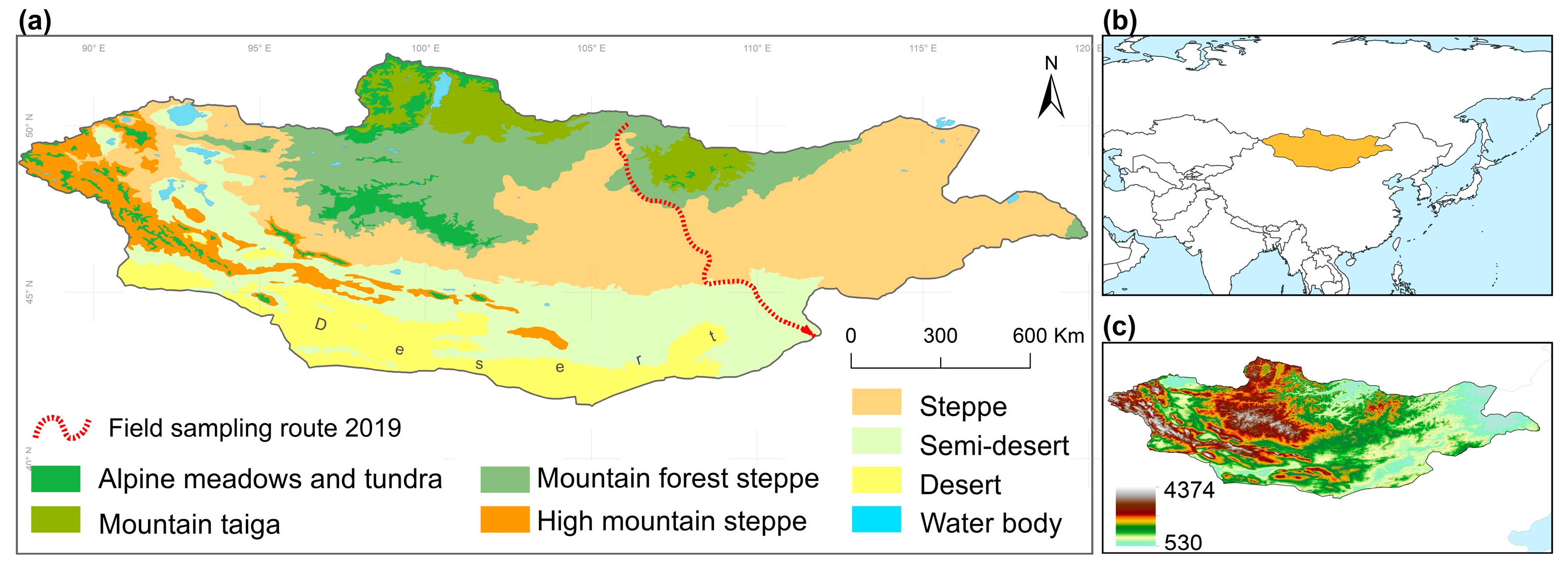
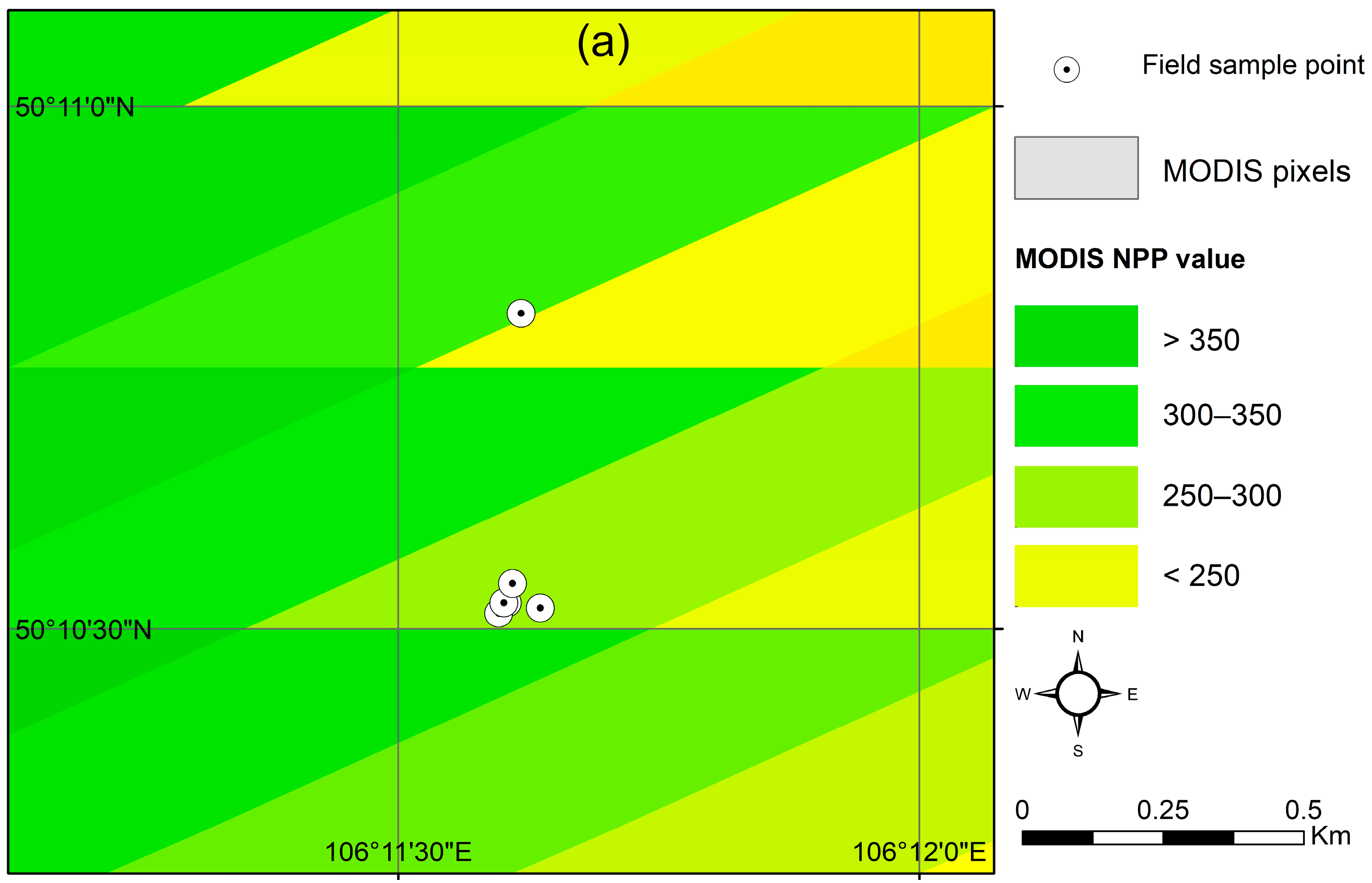
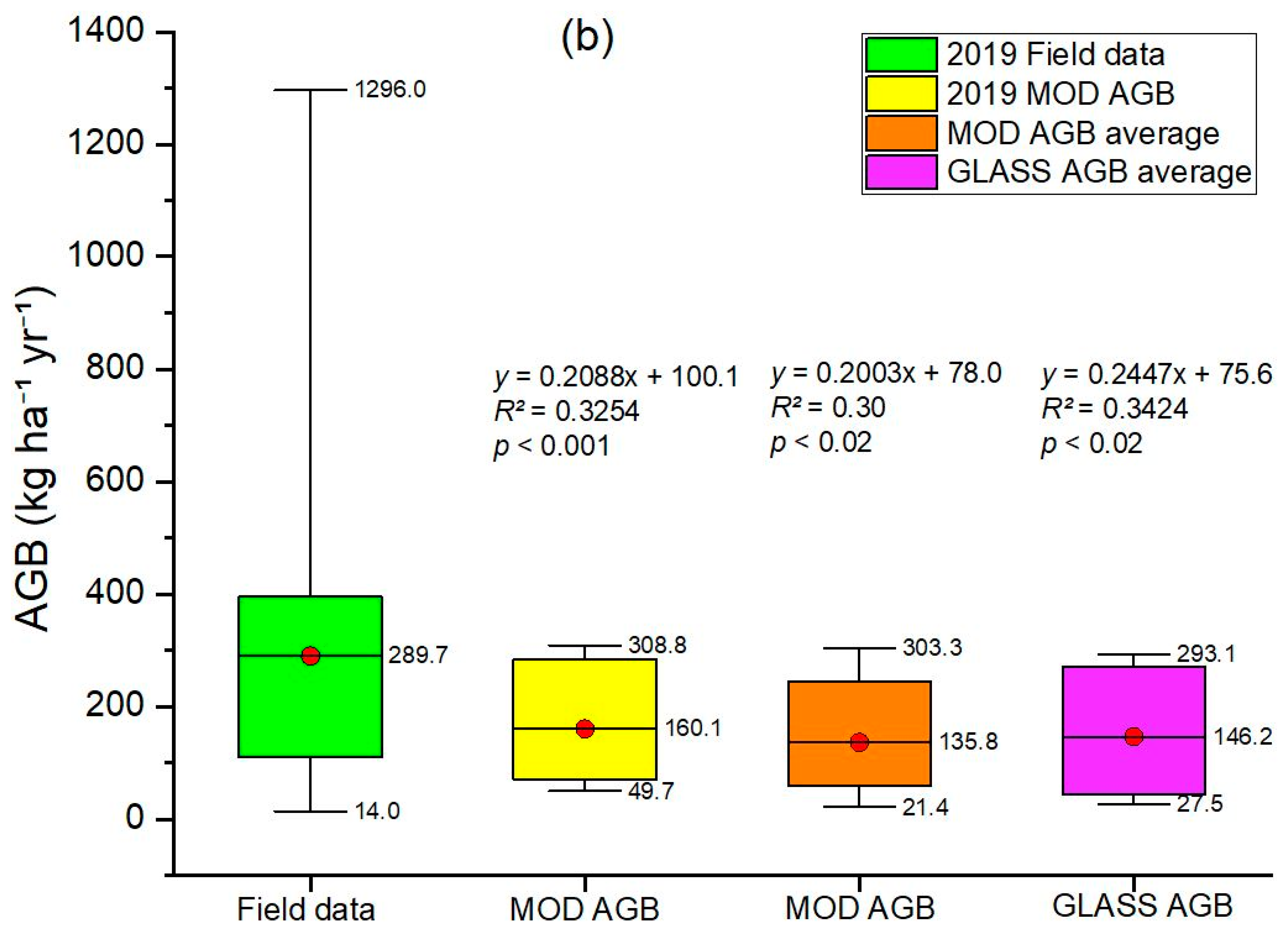
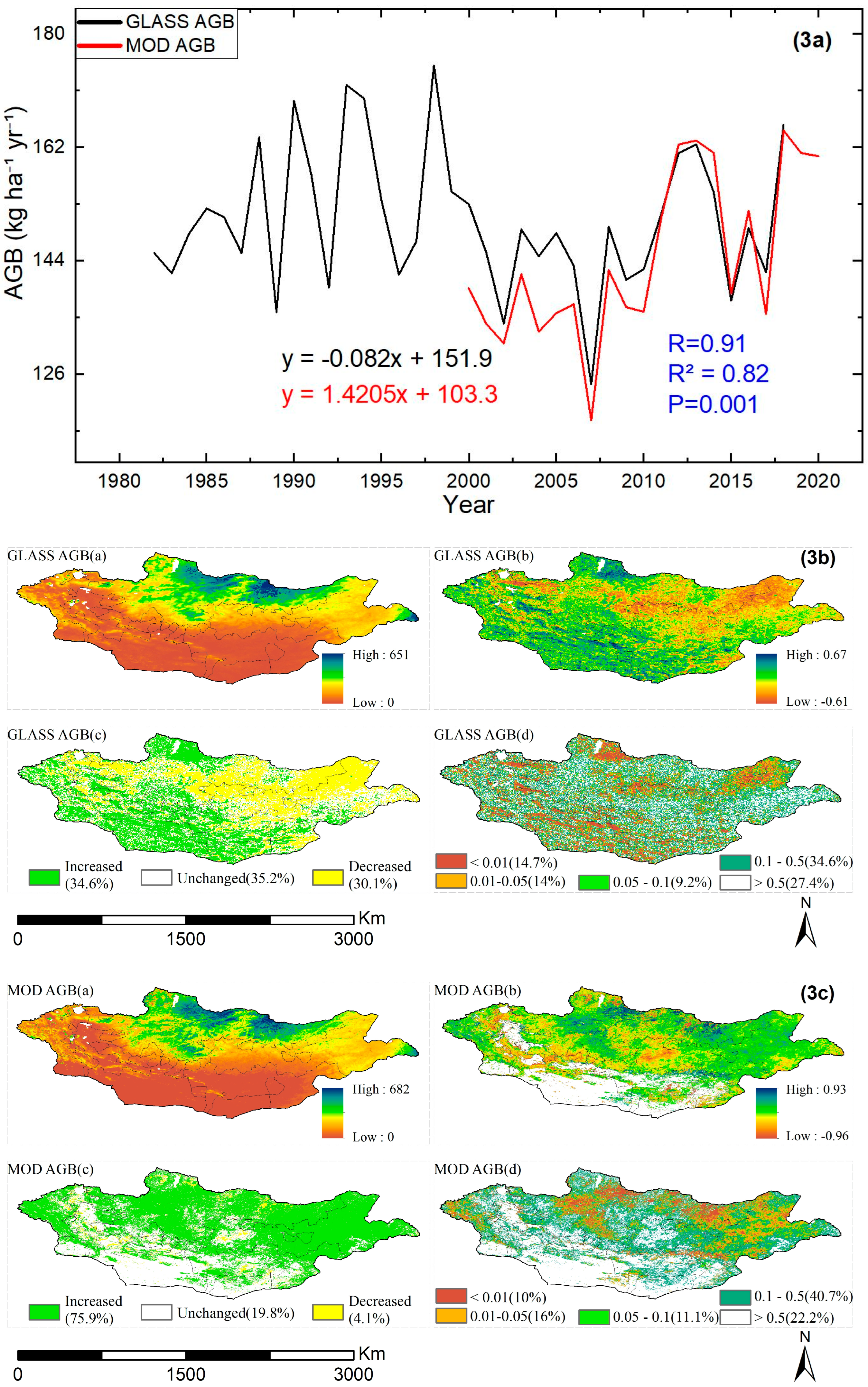
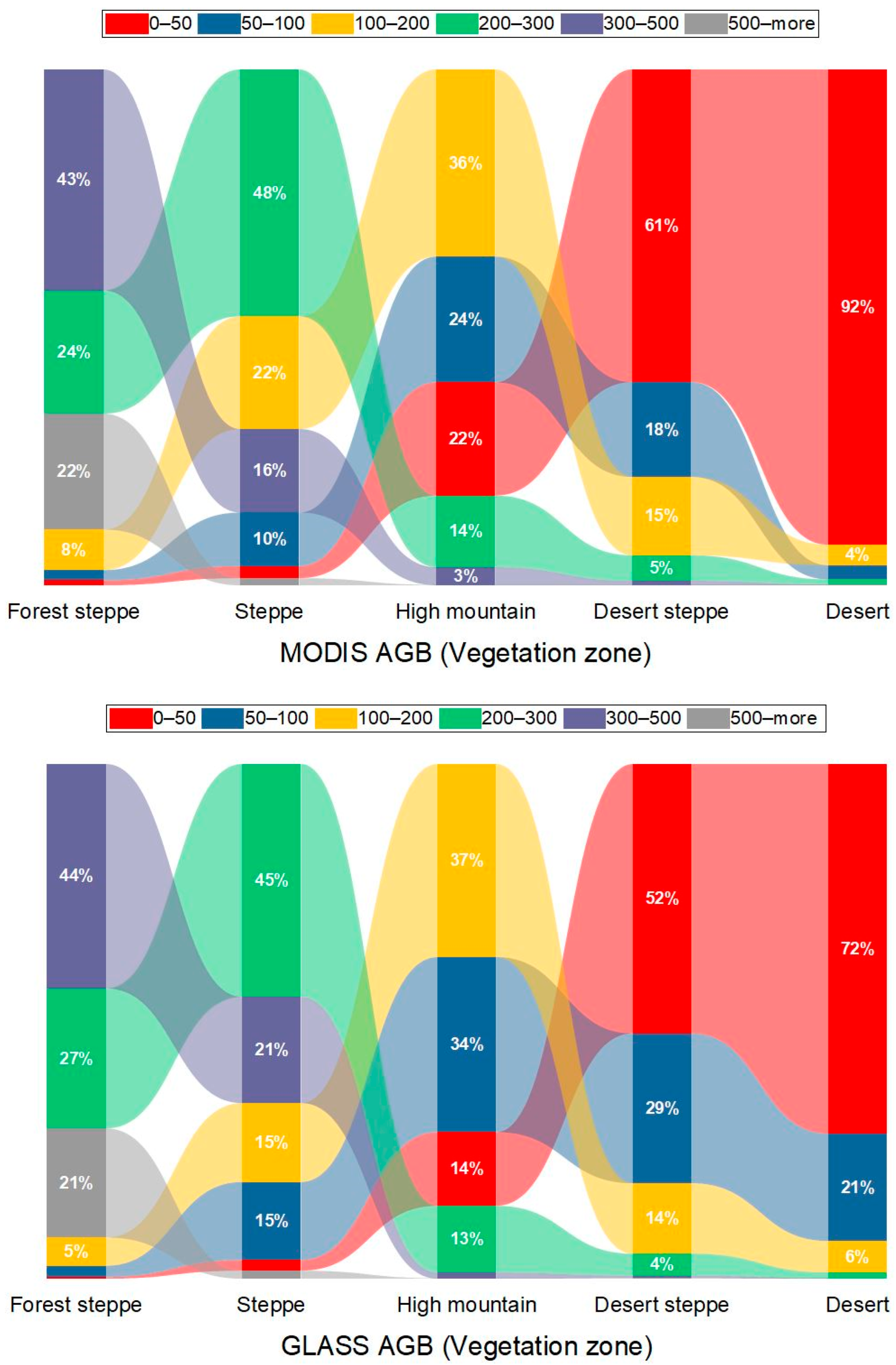
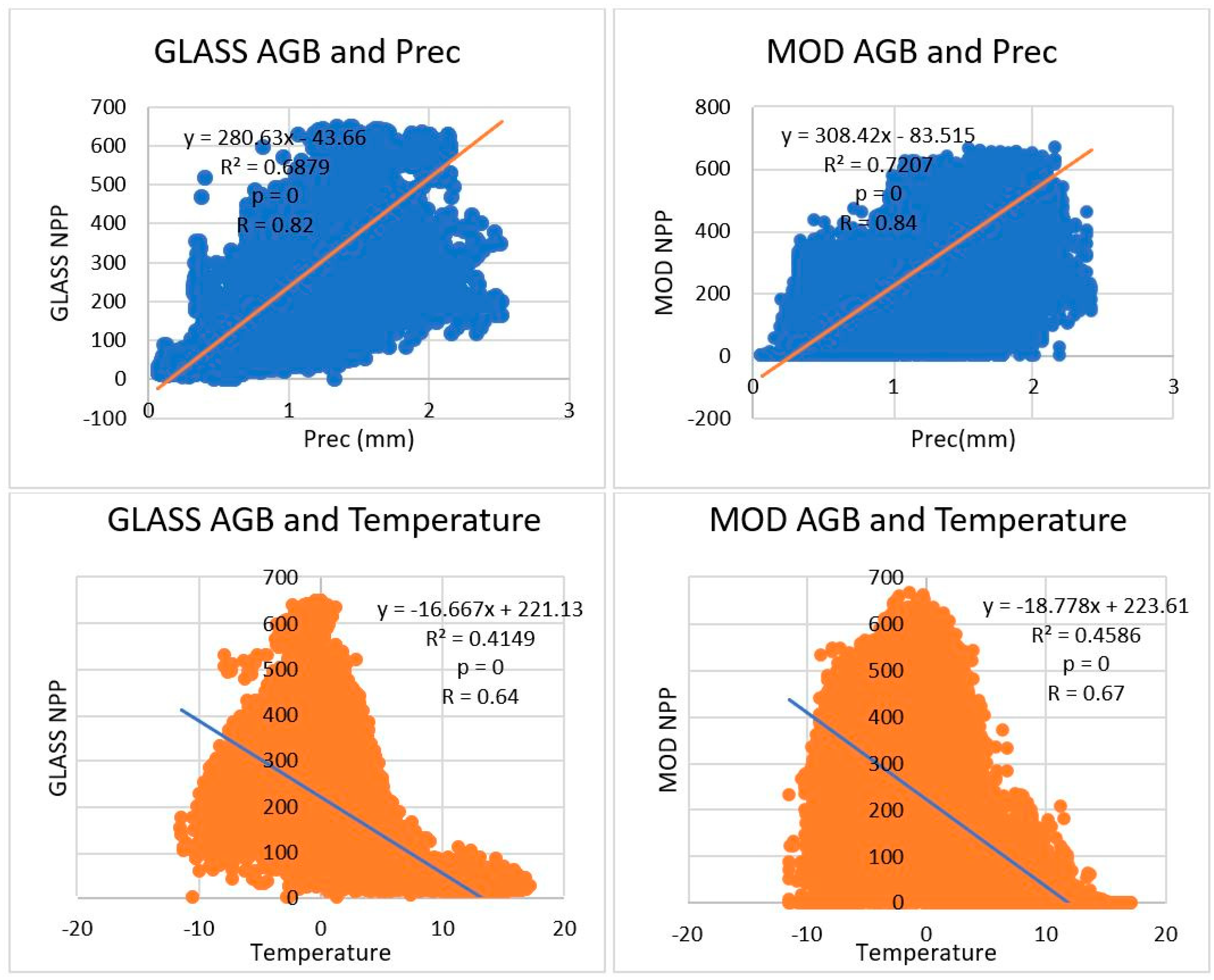


| Vegetation Zone | GLASS AGB (kg ha−1 yr−1) | MOD AGB (kg ha−1 yr−1) |
|---|---|---|
| Forest steppe | 1.1 | 1.6 |
| Steppe | 0.4 | 1.7 |
| High mountain | 0.1 | 0.5 |
| Desert steppe | 0.2 | 0.4 |
| Desert | 0.3 | 0.04 |
| The Livestock Number That Can Be Fed (%) | ||
|---|---|---|
| Livestock Number (SU) | GLASS (%) | MODIS (%) |
| <50,000 | 24.5 | 41.6 |
| 50,001–150,000 | 53.3 | 35.0 |
| 150,001–300,000 | 15.3 | 16.4 |
| 300,001–500,000 | 3.5 | 3.6 |
| >500,001 | 3.4 | 3.3 |
| GCCe | Grazing Conditions | GLASS (%) | MODIS (%) |
|---|---|---|---|
| >5 | Extremely overgrazing | 12.4 | 37.5 |
| 3–5 | Overgrazing | 16.3 | 10.9 |
| 1–3 | Moderate grazing | 30.6 | 19.7 |
| 0.5–1 | Light grazing | 27.3 | 20.8 |
| 0–0.5 | Reserve | 13.4 | 11.1 |
Disclaimer/Publisher’s Note: The statements, opinions and data contained in all publications are solely those of the individual author(s) and contributor(s) and not of MDPI and/or the editor(s). MDPI and/or the editor(s) disclaim responsibility for any injury to people or property resulting from any ideas, methods, instructions or products referred to in the content. |
© 2025 by the authors. Licensee MDPI, Basel, Switzerland. This article is an open access article distributed under the terms and conditions of the Creative Commons Attribution (CC BY) license (https://creativecommons.org/licenses/by/4.0/).
Share and Cite
Rentsenduger, B.; Guo, Q.; Chuluunbat, J.; Baatar, D.; Urtnasan, M.; Avirmed, D.; Li, S. Spatio-Temporal Variations in Grassland Carrying Capacity Derived from Remote Sensing NPP in Mongolia. Sustainability 2025, 17, 5498. https://doi.org/10.3390/su17125498
Rentsenduger B, Guo Q, Chuluunbat J, Baatar D, Urtnasan M, Avirmed D, Li S. Spatio-Temporal Variations in Grassland Carrying Capacity Derived from Remote Sensing NPP in Mongolia. Sustainability. 2025; 17(12):5498. https://doi.org/10.3390/su17125498
Chicago/Turabian StyleRentsenduger, Boldbayar, Qun Guo, Javzandolgor Chuluunbat, Dul Baatar, Mandakh Urtnasan, Dashtseren Avirmed, and Shenggong Li. 2025. "Spatio-Temporal Variations in Grassland Carrying Capacity Derived from Remote Sensing NPP in Mongolia" Sustainability 17, no. 12: 5498. https://doi.org/10.3390/su17125498
APA StyleRentsenduger, B., Guo, Q., Chuluunbat, J., Baatar, D., Urtnasan, M., Avirmed, D., & Li, S. (2025). Spatio-Temporal Variations in Grassland Carrying Capacity Derived from Remote Sensing NPP in Mongolia. Sustainability, 17(12), 5498. https://doi.org/10.3390/su17125498





